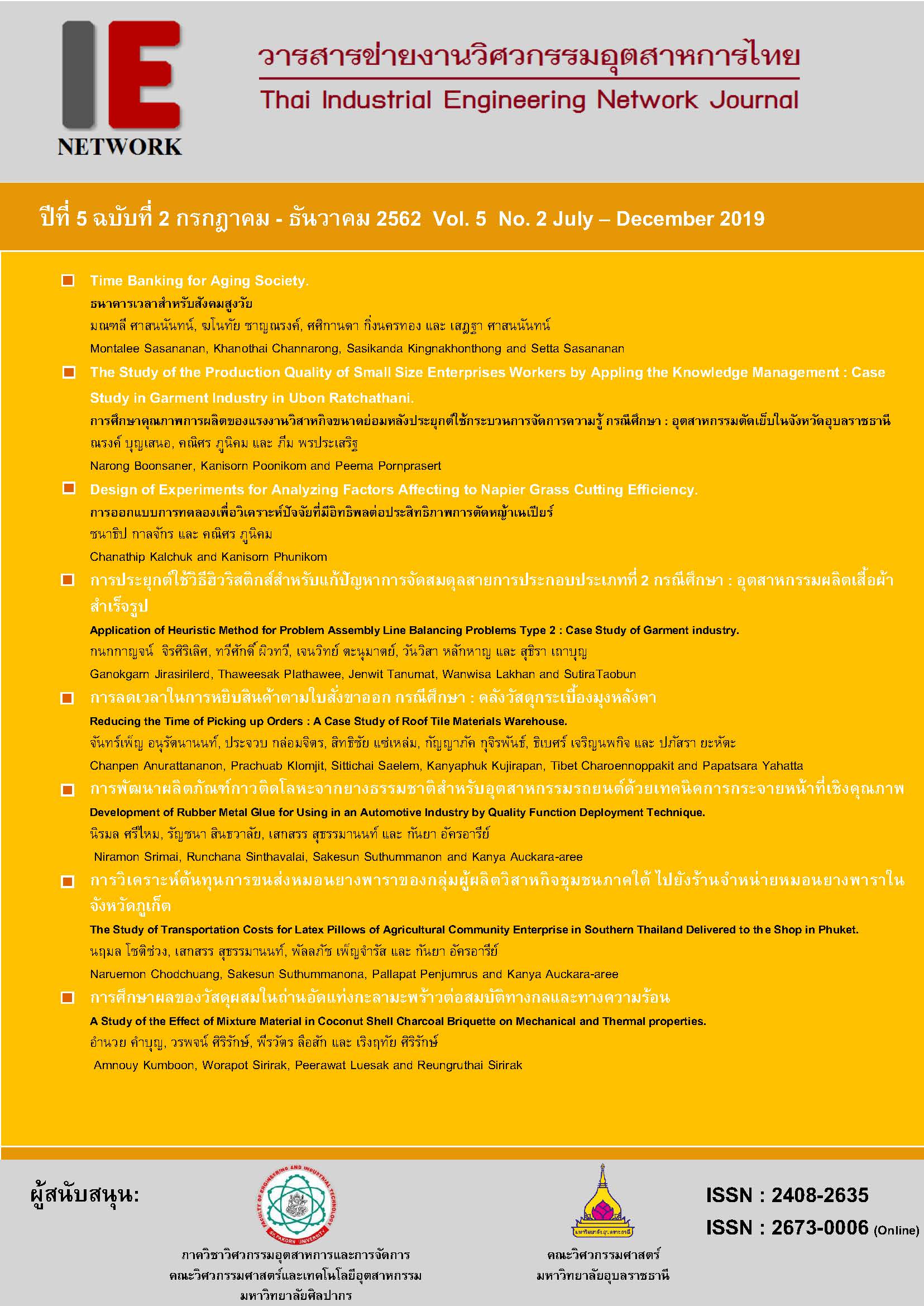Time Banking for Aging Society ธนาคารเวลาสำหรับสังคมสูงวัย
Main Article Content
Abstract
In 2021, Thailand will become a full-scale aging society when 20% of the population will be over sixty years old. This will cause significant societal changes, and it is very important that the country is prepared to deal with problems arising from being an aging society. An effective social welfare system is needed. Time banking system may serve as a key tool for coping with aging society. This article investigates the possibility of establishing time bank in Bangkok and vicinity by conducting a large-scale survey in the areas and using descriptive statistics and chi-square test of significance to determine the interests in joining time bank. It was found that nearly all respondents (90.2%) had never heard about time bank, and more than half of them indicated that they would like to become members. In terms of service activities, there were matches between receiving and offering services in the areas of helping with household chores and escorting people to doctor visits. This reflected that members could fulfill the needs of one another. As for the underlying factors affecting the degree of interest in joining time bank, it was found that gender and income had no correlation with a desire to join time bank, whereas the age of respondents seemed to be a significant factor. People of different ages had different levels of interest in becoming members. There was a notably low interest among people over 60 years old. If time bank is to be used as a key tool for solving aging society problems, further strategy is needed to attract senior citizens. In general, the study reveals that it is possible to establish a time bank in the urban areas of Thailand.
Article Details
บทความ ข้อมูล เนื้อหา รูปภาพ ฯลฯ ที่ได้รับการตีพิมพ์ในวารสารฯ ถือเป็นลิขสิทธิ์ของวารสารฯ หากบุคคลหรือหน่วยงานใดต้องการนำทั้งหมดหรือส่วนหนึ่งส่วนใดไปเผยแพร่ต่อหรือเพื่อกระทำการใดๆ จะได้รับอนุญาต แต่ห้ามนำไปใช้เพื่่อประโยชน์ทางธุรกิจ และห้ามดัดแปลง
References
[2] Sahay, R., Čihák, M., N'Diaye, P., Barajas, A., Mitra, S., Kyobe, A., Mooi, Y.N., and Yousefi, R., “Financial Inclusion: Can it Meet Multiple Macroeconomic Goals?”, IMF Staff Discussion Note (SDN/15/17). Washington, D.C.: International Monetary Fund, 2015.
[3] Mehrotra, A., and Yetman, J., Financial Inclusion–issues for Central Banks, BIS Quarterly Review, 2015
[4] BLA Health Plan, Forecasting of Health Care Costs in the Next 12 Years, https://www.bangkoklife.com/healthplan/th/knowledge/detail/1?pno=2
[5] Suwanrada, W., Sasat, S., Witvorapong, N., and Kumruangrit, S., “The Cost of Institutional Long Term Care for Older Persons: a Case Study of Thammapakorn Social Welfare Development Center for Older Persons, Chiang Mai Province”, Journal of Health Systems Research, Vol.10 (2), 2016. pp. 152-166.
[6] TCIJ, “Costs of care for elderly persons skyrocket”, TCIJ newspaper, 12 November 2017. Retrieved from https://www.tcijthai.com/news/2017/11/scoop/7501)
[7] The Nation, “Over 2000 volunteers sign up for time bank”, The Nation Newspaper, 2 June 2019. Retrieved from
https://forum.thaivisa.com/topic/1104231-over-2000-volunteers-sign-up-for-time-bank/
[8] Cahn E.S., “On LETS and Time Dollars”, International Journal of Community Currency Research, Vol.5, January, 2001
[9] Seyfang, G., “Working outside the box: community currencies, time banks and social inclusion”, Journal of Social Policy, Vol.33 (1), 2004. pp 49-71
[10] James, S., The impact of co-production on people outside of paid work, Rhondda: Wales Institute for community currency, 2005.
[11] Ozanne L. K., “Learning to exchange time: Benefits and obstacles to time banking”, International Journal of Community Currency Research, Vol. 14, 2010. pp 1-16
[12] Pearson, O., Co-producing the school? A case study of youth participation in time banking, Ph.D. Thesis. Cardiff University, 2015
[13] Valek, L., Time banks as systematic approach in solution of economical problems on local scale: The Czech Republic situation. Prague Czech Republic: Systematic approaches, 2013d
[14] Valek, L., “The Time Bank Implementation and governance: Is PRINCE 2 suitable?” Procedia Technology, Vol.16, 2014. pp 950-956.
[15] Valek L., “Risk factors and issues to keep in mind while implementing the time bank: Learning from success and failure”, 22nd International Business Information Management Association Conference, Rome, Italy, 2013
[16] Espín, L.D. and Pais, I., “Feminization of labour, defeminization of time banks: digital time banking and unpaid virtual work”, International Journal of Media and Cultural Politics, Vol.14 (1), 2018. pp 55-75
[17] Lashko, G., “Time banking- new social currency or waste of time?”, Housing, Care and Support, Vol. 15 (4), 2012. pp.161-168
[18] Nebot, N. and Jere, N. Developing a time bank application for Havana informal settlement, Southern Africa Telecommunication Networks and Applications Conference (SATNAC), Western Cape, South Africa, September 2018
[19] Cahn, E. and Gray, C., “The time bank solution”, Stanford Social Innovation Review, Summer 2015.
[20] National Statistics Bureau, Size and population structure based on age and gender, December 8, 2017,
https://statbbi.nso.go.th/staticreport/page/sector/th/01.aspx
[21] Best, J.W., Research in Education, 4th Ed. Prentice-Hall, New Jersey, 1981


